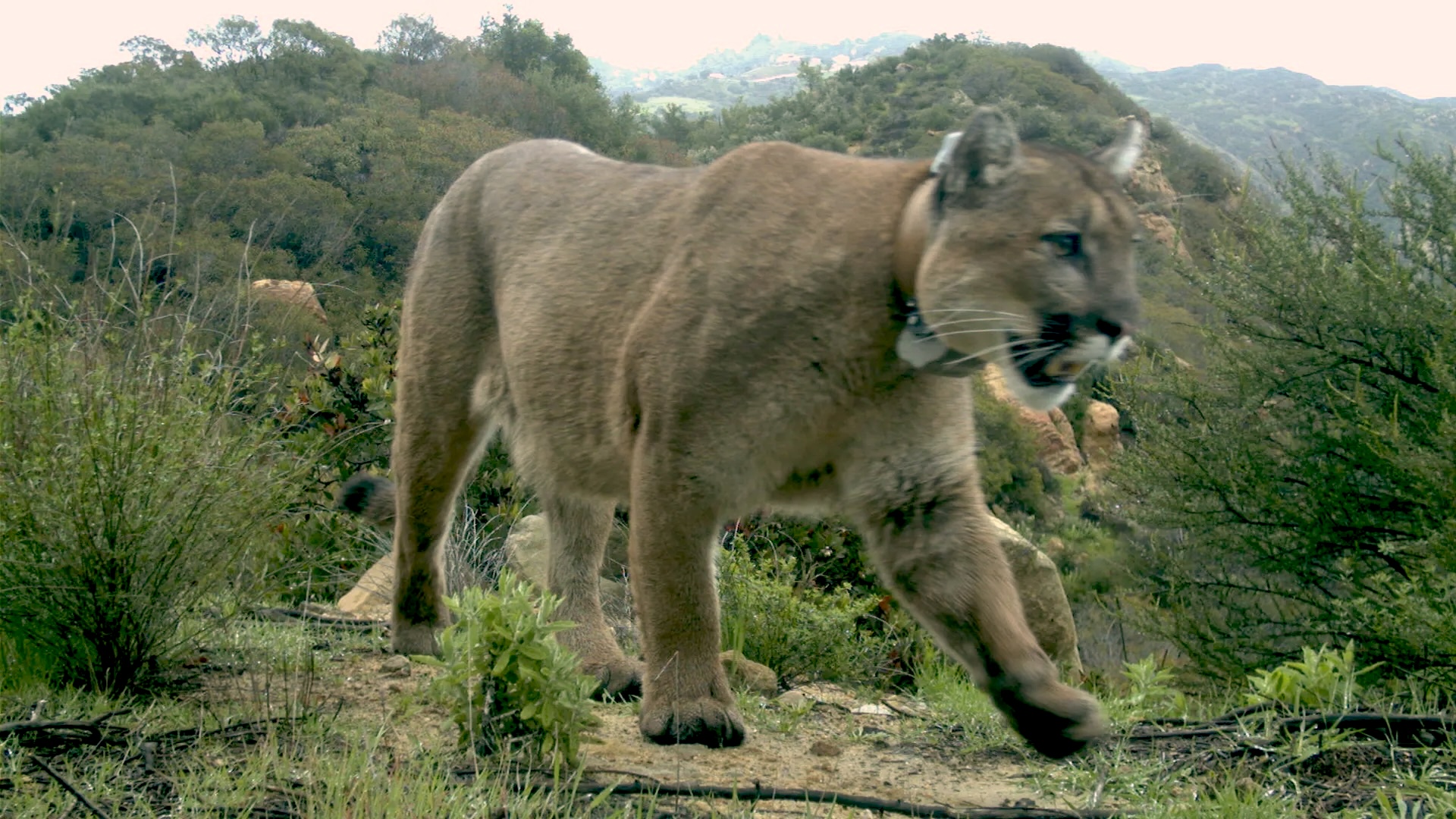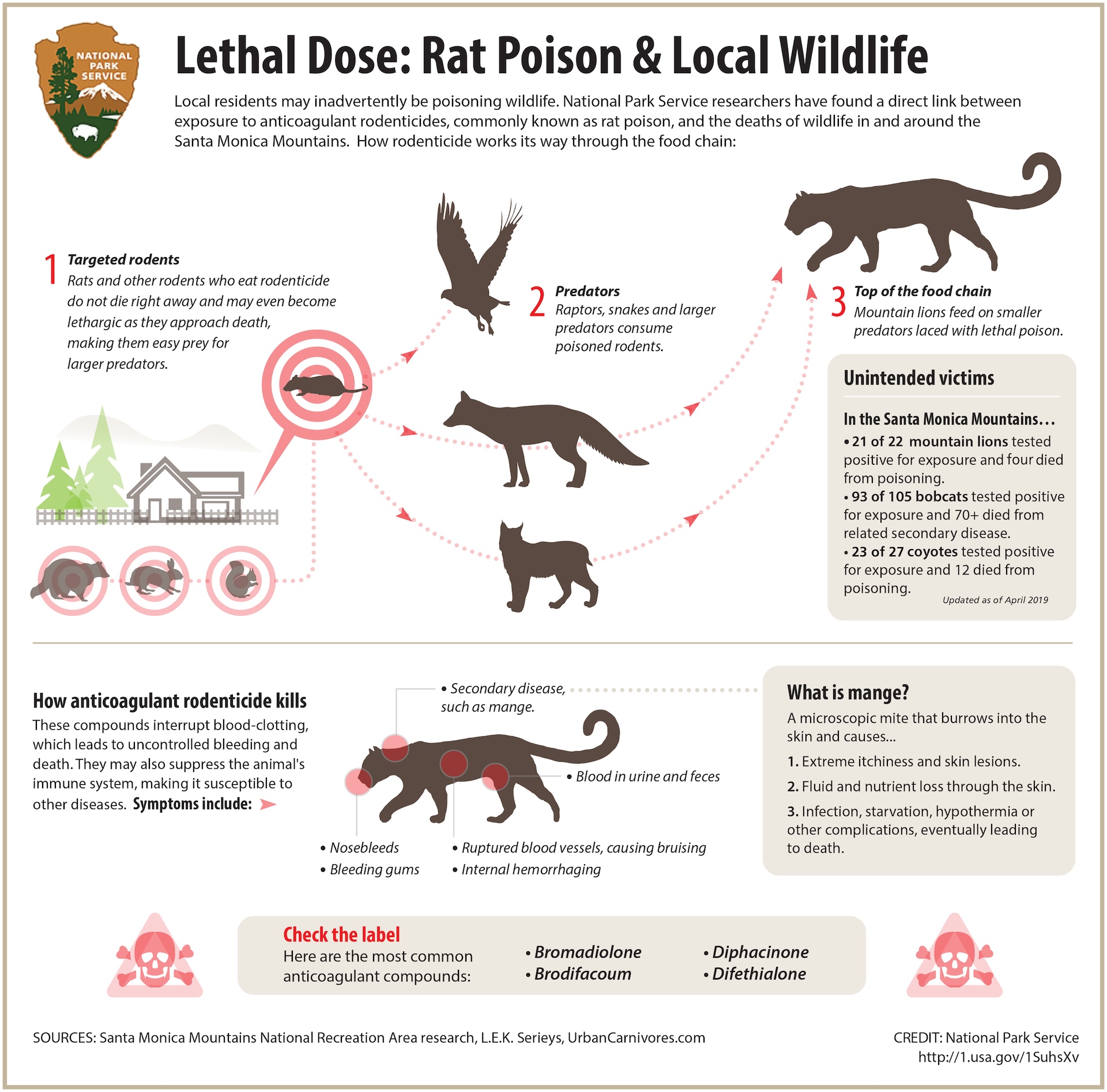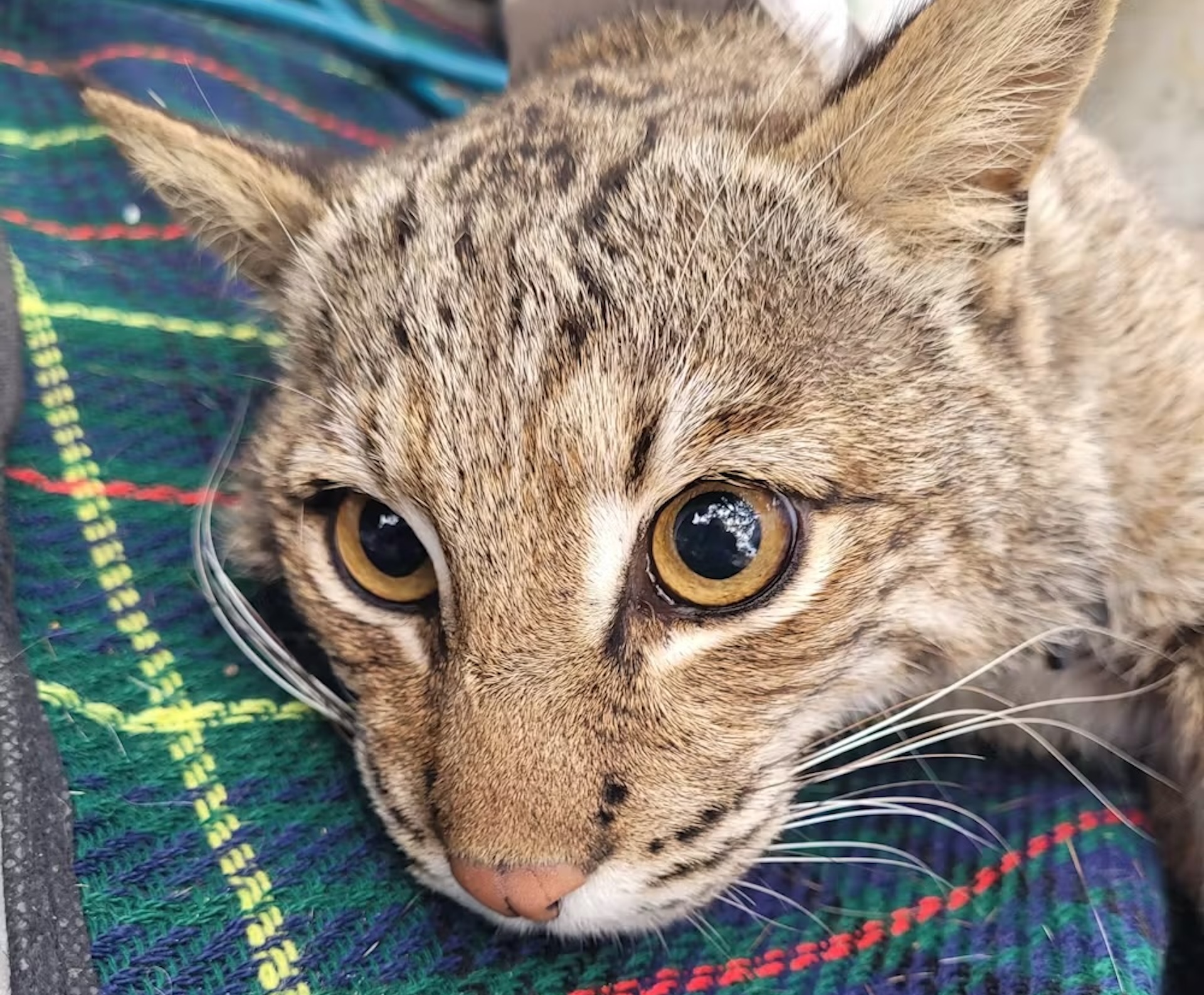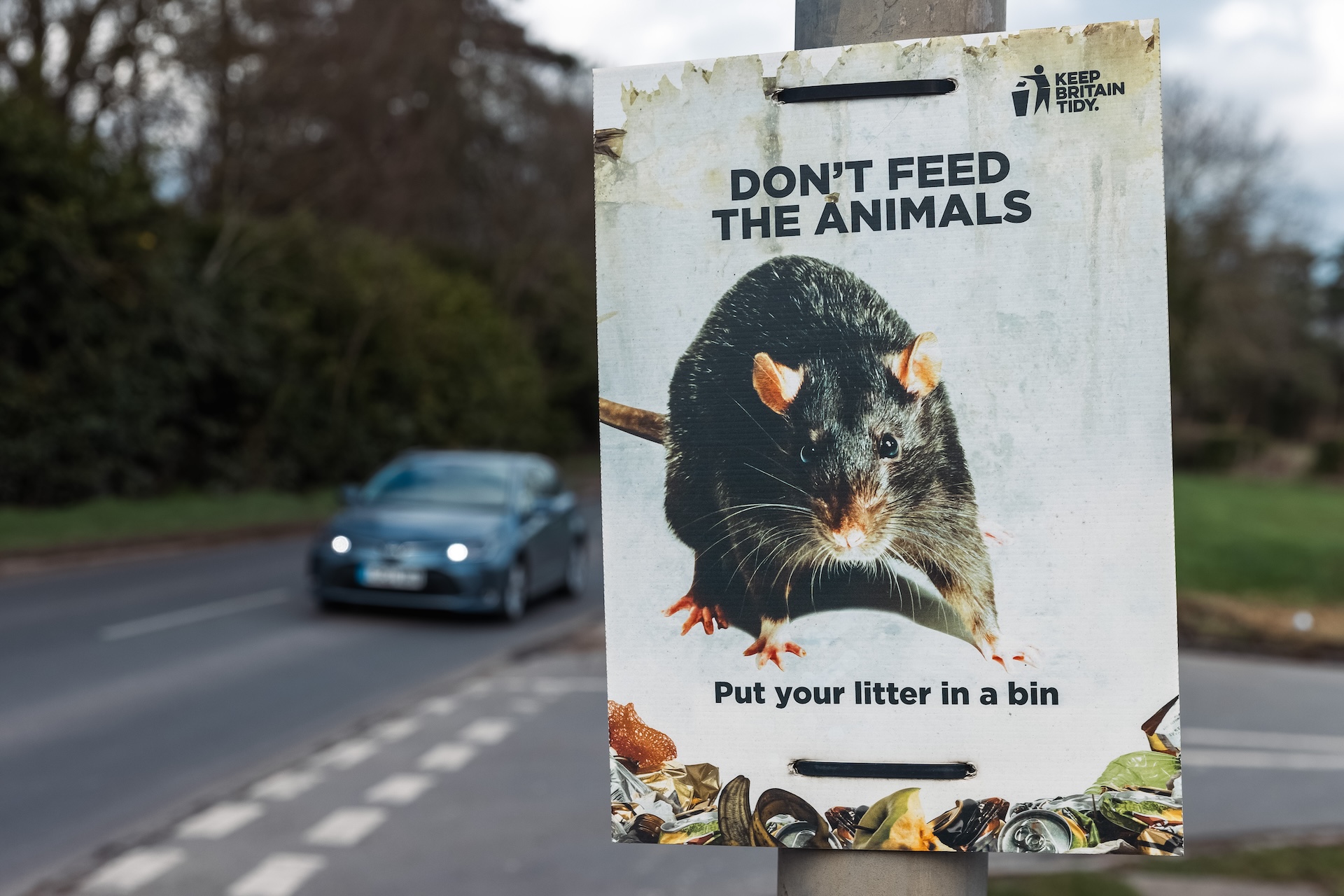Rat poison is ripping through the food chain, threatening predators at the very top
Rat poison detected in around a third of wild mammal carnivores — including those that don't normally eat rodents, such as mountain lions and gray wolves.

Rats thrive around humans, for good reason: They feed off crops and garbage and readily adapt to many settings, from farms to the world's largest cities. To control them, people often resort to poisons. But chemicals that kill rats can also harm other animals.
The most commonly used poisons are called anticoagulant rodenticides. They work by interfering with blood clotting in animals that consume them. These enticingly flavored bait blocks are placed outside of buildings, in small black boxes that only rats and mice can enter. But the poison remains in the rodents' bodies, threatening larger animals that prey on them.
My colleagues and I recently reviewed studies from around the world that sought to document wild mammal carnivores' exposure to anticoagulant rodenticides. Many animals tested in these studies were already dead; others were alive and a part of other studies.
Researchers detected rodenticides in about one-third of the animals in these analyses, including bobcats, foxes and weasels. They directly linked the poisons to the deaths of one-third of the deceased animals — typically, by finding the chemicals in the animals' liver tissues.
RELATED: Rat poison harms famous California cougar
Most poisons that these studies detected were so-called second-generation anticoagulant rodenticides, developed since 1970. These products are used exclusively in residential and urban areas and can kill a rat or mouse after just one night's feeding. First-generation rodenticides, which typically are used only on farms, require several doses to kill.
These poisons are widely available, and their use is largely unregulated in most countries. Using rodenticides is projected to increase and may be contributing to declines in many carnivore species around the world.
Sign up for the Live Science daily newsletter now
Get the world’s most fascinating discoveries delivered straight to your inbox.
Rising through food chains
When wild animals consume rat poison — typically, by eating a poisoned rat — the effects may include internal bleeding and lesions, lethargy and a reduced immune response, which can make them more susceptible to other diseases. In many cases the animal will die. Sometimes these deaths occur at scales large enough to reduce local predator populations.
We began our review by compiling a list of 34 species known to be exposed to rat poisons. They included members of the weasel and dog families, such as stoats, western polecats and red foxes, along with wild cats and other carnivores.
Some of these predators, such as mountain lions and gray wolves, don't usually hunt rodents. Rodenticides have even been detected in semiaquatic predators such as river otters, which normally eat crustaceans and fish.
It's likely that large carnivores such as wolves are consuming rat poison by eating other poisoned carnivores, such as raccoons and bobcats.

This movement of poisons up the food chain is called bioaccumulation. In the best-known example, bald eagles and other birds of prey were exposed to the pesticide DDT in fish they consumed before the U.S. banned DDT in 1972. Many affected species, including bald eagles, ospreys and peregrine falcons, were drastically reduced for years due to the effects of DDT on their populations.
RELATED: Massive DDT dumping ground found off the Los Angeles coast is bigger than anyone thought
Carnivores at risk
We found dozens of previous studies that attempted to quantify exposure risk, usually by examining animals' habitats. Some studies found an elevated risk of consuming rat poison in urban and agricultural areas, but many also found a high correlation with natural spaces.
For example, a 2012 study found rodenticides in fishers and martens that spent time near illegal cannabis growing sites in Humboldt County, California, where growers were protecting their fields with rat poisons.
Other potential contributors to exposure included the animal's sex and age. All in all, understanding which animals are at risk requires more study.
A post shared by City of Pickering (@cityofpickering)
A photo posted by on
Most research on this topic is being conducted in North America and Europe. Only a handful of studies to date have focused on South Africa, New Zealand or Australia, although over half of all carnivore species of global concern are found in Asia, Africa or South America.
In Africa, for example, anticoagulant rat poisons could threaten species such as the black-footed cat, which is classified as vulnerable. These poisons are also widely used across Asia, particularly at palm oil plantations. Many wild species live in this type of forested agricultural area, including carnivores that hunt rodents, such as common palm civets and leopard cats.
Our study found that 19% of carnivore species on the International Union for Conservation of Nature's Red List of threatened species have ranges that overlap entirely or partially with countries where rat poison exposure has been documented in wildlife. However, only 2% of Red List species list rodenticides as a recognized threat, and none are included in the 19% that our review indicates may be threatened by rodenticide exposure. This suggests that wildlife researchers and conservationists are not fully aware of the reach of these poisons.
Kiawah bobcats
I am doing my dissertation research on South Carolina's Kiawah Island, where biologists have detected anticoagulant rodenticides in bobcats. The island's bobcats have been GPS-collared and monitored since the early 2000s in one of the longest multigenerational studies of a carnivore in the world.

In late 2019 and early 2020, three bobcats were found dead due to rodenticide poisoning, including two females that died while giving birth. The bobcat population dropped from an estimated 30 to as few as 10 individual cats. These deaths attracted media attention, spurred efforts to curtail use of poisons on the island and kick-started research to understand how rat poisons were affecting bobcats.
Kiawah is a popular resort destination, but these bobcats have persisted through decades of housing development. Part of my work seeks to tease apart how rodenticides and urbanization are affecting the cats.
In 2020, Kiawah residents volunteered to stop using rodenticides on the island, and the town government carried out public education campaigns explaining the threat to wildlife. Today there are about 20 bobcats on the island, and work continues to end use of rodenticides.

These poisons have contributed to the deaths of other charismatic animals, including urban mountain lions in Southern California and Flaco, a Eurasian eagle-owl who escaped from New York City's Central Park Zoo and lived for months in the park. In Europe, rodenticides have been found in the carcasses of Italian wolves.
Rats damage property, contaminate food and spread diseases, so controlling them is a human health concern. However, my research adds to evidence that better control methods are needed to reduce the need for anticoagulant rodenticides.
Community-level efforts like those on Kiawah Island can help. So can cleaning up trash in cities. But better regulation and tracking of rat poison use is likely to be needed in many places around the world.
This edited article is republished from The Conversation under a Creative Commons license. Read the original article.

Meghan Keating is a PhD candidate studying urban carnivore space use and survival. Her current work focuses on the long-term effects of human development and rodenticide use on bobcat populations in the southeastern US and globally. Her master's work focused on the ecological drivers of mule deer movement in the Mojave Desert Preserve. Meghan has also participated in research at USGS's Western Ecological Research Center looking at predator-prey interactions and space-use.










